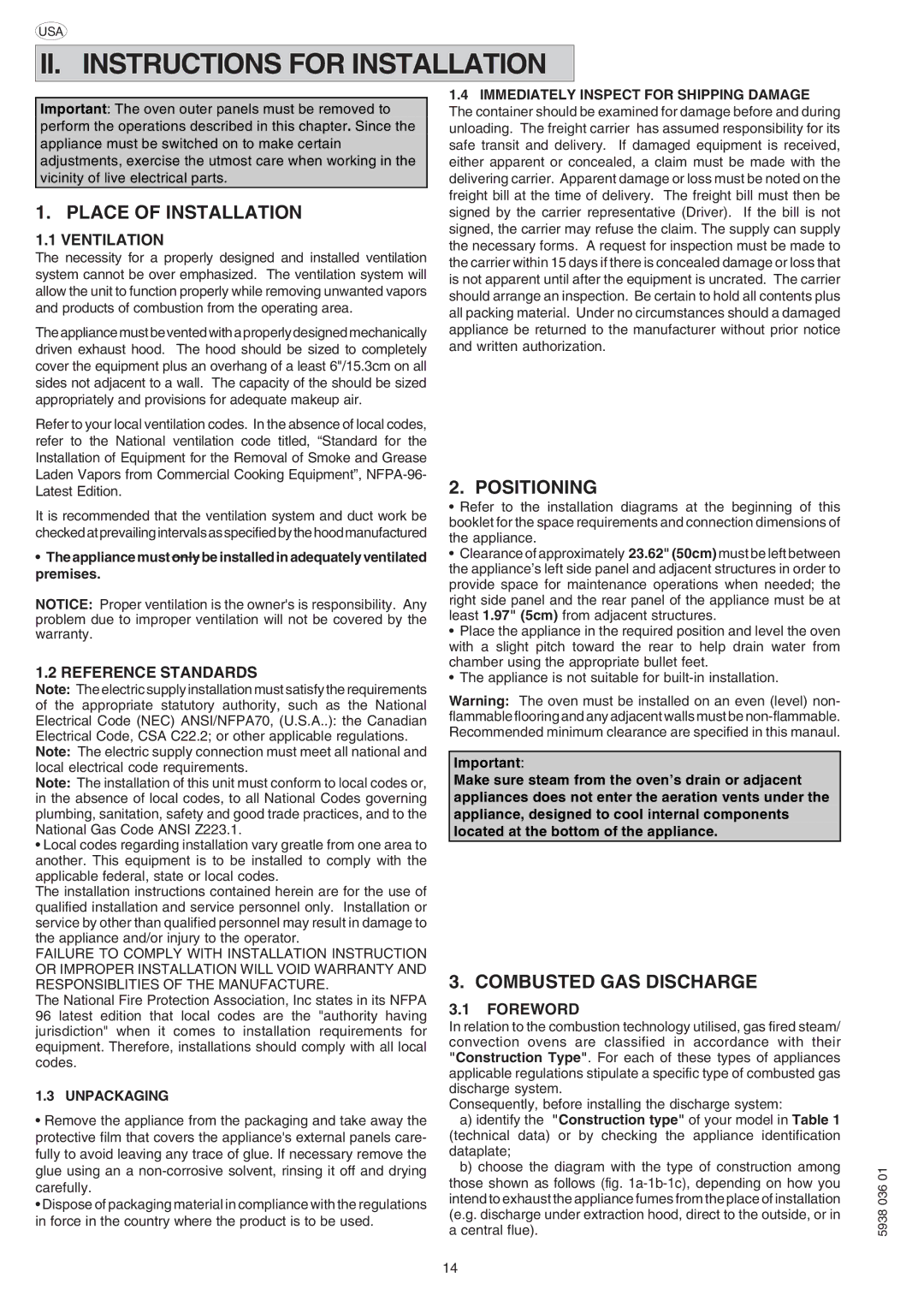Important: The oven outer panels must be removed to
perform the operations described in this chapter. Since the
appliance must be switched on to make certain
adjustments, exercise the utmost care when working in the
vicinity of live electrical parts.
1. PLACE OF INSTALLATION
1.1 VENTILATION
The necessity for a properly designed and installed ventilation system cannot be over emphasized. The ventilation system will allow the unit to function properly while removing unwanted vapors and products of combustion from the operating area.
Theappliancemustbeventedwithaproperlydesignedmechanically driven exhaust hood. The hood should be sized to completely cover the equipment plus an overhang of a least 6"/15.3cm on all sides not adjacent to a wall. The capacity of the should be sized appropriately and provisions for adequate makeup air.
Refer to your local ventilation codes. In the absence of local codes, refer to the National ventilation code titled, “Standard for the Installation of Equipment for the Removal of Smoke and Grease Laden Vapors from Commercial Cooking Equipment”, NFPA-96- Latest Edition.
It is recommended that the ventilation system and duct work be checkedatprevailingintervalsasspecifiedbythehoodmanufactured
•The appliance must only be installed in adequately ventilated premises.
NOTICE: Proper ventilation is the owner's is responsibility. Any problem due to improper ventilation will not be covered by the warranty.
1.2 REFERENCE STANDARDS
Note: The electric supply installation must satisfy the requirements of the appropriate statutory authority, such as the National Electrical Code (NEC) ANSI/NFPA70, (U.S.A..): the Canadian Electrical Code, CSA C22.2; or other applicable regulations.
Note: The electric supply connection must meet all national and local electrical code requirements.
Note: The installation of this unit must conform to local codes or, in the absence of local codes, to all National Codes governing plumbing, sanitation, safety and good trade practices, and to the National Gas Code ANSI Z223.1.
•Local codes regarding installation vary greatle from one area to another. This equipment is to be installed to comply with the applicable federal, state or local codes.
The installation instructions contained herein are for the use of qualified installation and service personnel only. Installation or service by other than qualified personnel may result in damage to the appliance and/or injury to the operator.
FAILURE TO COMPLY WITH INSTALLATION INSTRUCTION OR IMPROPER INSTALLATION WILL VOID WARRANTY AND RESPONSIBLITIES OF THE MANUFACTURE.
The National Fire Protection Association, Inc states in its NFPA 96 latest edition that local codes are the "authority having jurisdiction" when it comes to installation requirements for equipment. Therefore, installations should comply with all local codes.
1.3 UNPACKAGING
•Remove the appliance from the packaging and take away the protective film that covers the appliance's external panels care- fully to avoid leaving any trace of glue. If necessary remove the glue using an a non-corrosive solvent, rinsing it off and drying carefully.
•Dispose of packaging material in compliance with the regulations in force in the country where the product is to be used.
1.4IMMEDIATELY INSPECT FOR SHIPPING DAMAGE
The container should be examined for damage before and during unloading. The freight carrier has assumed responsibility for its safe transit and delivery. If damaged equipment is received, either apparent or concealed, a claim must be made with the delivering carrier. Apparent damage or loss must be noted on the freight bill at the time of delivery. The freight bill must then be signed by the carrier representative (Driver). If the bill is not signed, the carrier may refuse the claim. The supply can supply the necessary forms. A request for inspection must be made to the carrier within 15 days if there is concealed damage or loss that is not apparent until after the equipment is uncrated. The carrier should arrange an inspection. Be certain to hold all contents plus all packing material. Under no circumstances should a damaged appliance be returned to the manufacturer without prior notice and written authorization.
2. POSITIONING
•Refer to the installation diagrams at the beginning of this booklet for the space requirements and connection dimensions of the appliance.
•Clearance of approximately 23.62" (50cm) must be left between the appliance’s left side panel and adjacent structures in order to provide space for maintenance operations when needed; the right side panel and the rear panel of the appliance must be at least 1.97" (5cm) from adjacent structures.
•Place the appliance in the required position and level the oven with a slight pitch toward the rear to help drain water from chamber using the appropriate bullet feet.
•The appliance is not suitable for built-in installation.
Warning: The oven must be installed on an even (level) non- flammable flooring and any adjacent walls must be non-flammable. Recommended minimum clearance are specified in this manaul.
Important:
Make sure steam from the oven’s drain or adjacent
appliances does not enter the aeration vents under the
appliance, designed to cool internal components
located at the bottom of the appliance.
3. COMBUSTED GAS DISCHARGE
3.1FOREWORD
In relation to the combustion technology utilised, gas fired steam/ convection ovens are classified in accordance with their "Construction Type". For each of these types of appliances applicable regulations stipulate a specific type of combusted gas discharge system.
Consequently, before installing the discharge system:
a)identify the "Construction type" of your model in Table 1 (technical data) or by checking the appliance identification dataplate;
b)choose the diagram with the type of construction among those shown as follows (fig. 1a-1b-1c), depending on how you intend to exhaust the appliance fumes from the place of installation (e.g. discharge under extraction hood, direct to the outside, or in a central flue).

